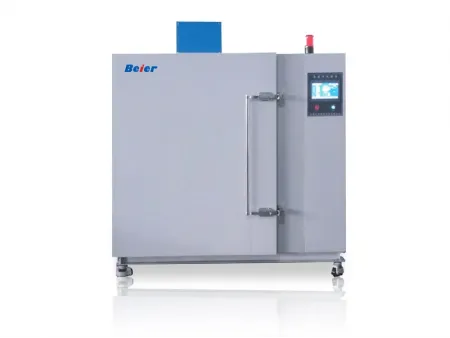Stability Test Chamber
Environmental test chamber tests the stability and durability of products at specific temperature and humidity
Beier’s stability test chamber accurately adjusts the temperature and humidity in the chamber through its control system to ensure that these parameters remain constant during the experiment. This control is usually achieved using advanced temperature control systems and humidity controllers, such as PID control technology and solid-state relays. At the same time, the stability test chamber is also equipped with equipment that simulates sunlight, such as the 2KW stability sunlight simulation lamp array test chamber, which can simulate various spectra of sunlight and provide constant light intensity, making the experimental results more accurate and reliable.
The stability chambers are commonly used for testing applications that include ICH guidelines, accelerated shelf-life studies, steady-state, stability, package testing, burn-in, curing, controlled temperature storage, and biomedical research among many others.
Standards
Stability test chamber adheres to standards: IEC61215, IEC61646, GB2423, ISO4892-2, IS4892-3.
Stability test chambers play a significant role in industries such as electronics, automotive, and aerospace.
- In the pharmaceutical industry, they can conduct drug stability tests to demonstrate how drug quality varies with environmental conditions such as temperature, humidity, and light exposure.
- In reliability testing of electronic components, stability test chambers can simulate different climate environments to test the durability and performance of components.
- Additionally, stability test chambers are commonly used in stability testing, shelf-life testing, and accelerated aging tests in fields such as packaging, life sciences, personal care, medical, and biomedical storage.
- Multiple models are available to meet diverse testing needs, from basic thermal cycling to accelerated stress testing.
- Some stability test chambers are designed to meet specific criteria with uniform light, temperature, and humidity distribution to meet testing requirements under different illumination conditions.
| Temperature Range | 40-60℃ |
| Irradiation Area | 2000×1200mm |
| Irradiation Distance | 1600mm |
| Irradiation Intensity | 600-1200W/m² |
| Non-uniformity | B level ≤5% |
| Instability | A level ≤2% |
- The chamber’s lower part serving as a workspace and the upper part housing a computer-simulated array of light sources.
- The chamber top is equipped with a return air inlet for air cooling exchange, cooling the incoming air to ensure stable temperature control.
- The side walls are constructed with steady-state sunlight simulation full reflective panels, serving as secondary sealing and specialized for optical reflection control.
- Structural strength: the total weight-bearing capacity of the bottom plate inside the chamber is greater than or equal to 250 Kg (evenly distributed).
- The door opens singly, with the door hinges located on both sides of the chamber, and has a handle. It features a door-opening light-cutoff protection device and a maintenance functionality.
- The sample rack can secure photovoltaic samples of various sizes: 2000x1200x50mm, 1652x1000x50mm, 1494x1000x45mm, 1580x808x45mm.
- Testing lead holes: one side of the chamber is equipped with a lead hole with a diameter of 100mm, equipped with an insulated heat-insulating plug.
- Light Source System: 4 units of steady-state sunlight simulation light sources
- Light Source Characteristics: Light intensity attenuation less than 10% after 1000 hours (using EPS)
- Arrangement: Linear array layout, computer-simulated spatial distribution
- Effective Irradiation Area: 2000x1200mm at an irradiation height of 1.6m
- Irradiation Parameters: Light intensity of 1000W/m2, non-uniformity distribution less than or equal to ±5%
- Lamp Type: 2kW (warranty for 2000 hours)
- Filter Type: H5.1 optical filter
- Regulation Method: Forced air circulation for temperature balance
- Heating Method: Nickel-chromium alloy electric heating wire, PID regulation, executive component: solid-state relay
- Air Cooling Method: Fin-type evaporator
- Compressor: Single-stage water-cooled unit, the core of the refrigeration system.
- Refrigerant: Environmentally friendly R404a
What are the roles of stability test chamber in the pharmaceutical industry?
In the pharmaceutical industry, stability test chambers are widely used for testing and evaluating the shelf life of drugs. Drugs are placed under specific conditions such as temperature, humidity, and light exposure to test their stability under those conditions.
Stability test chambers simulate climate conditions found in drug warehouses, pharmacies, and points of sale to determine safe transportation and storage methods for drugs.
What types of stability test chambers are provided by Beier?
Stability test chambers come in various sizes, shapes, and functionalities, but the two most common types are:
- Reach-In Stability Chambers: these are the most common type of stability test chambers. They feature front or side doors, temperature control, humidity control, and light control. These chambers are suitable for conducting stability studies on samples stored in bulk or small containers (such as vials, capsules, and tablets).
- Walk-In Stability Chambers: these chambers are used for large-scale studies and have much larger internal spaces compared to reach-in chambers. These chambers can accommodate larger samples, such as bulk drugs and larger containers.
